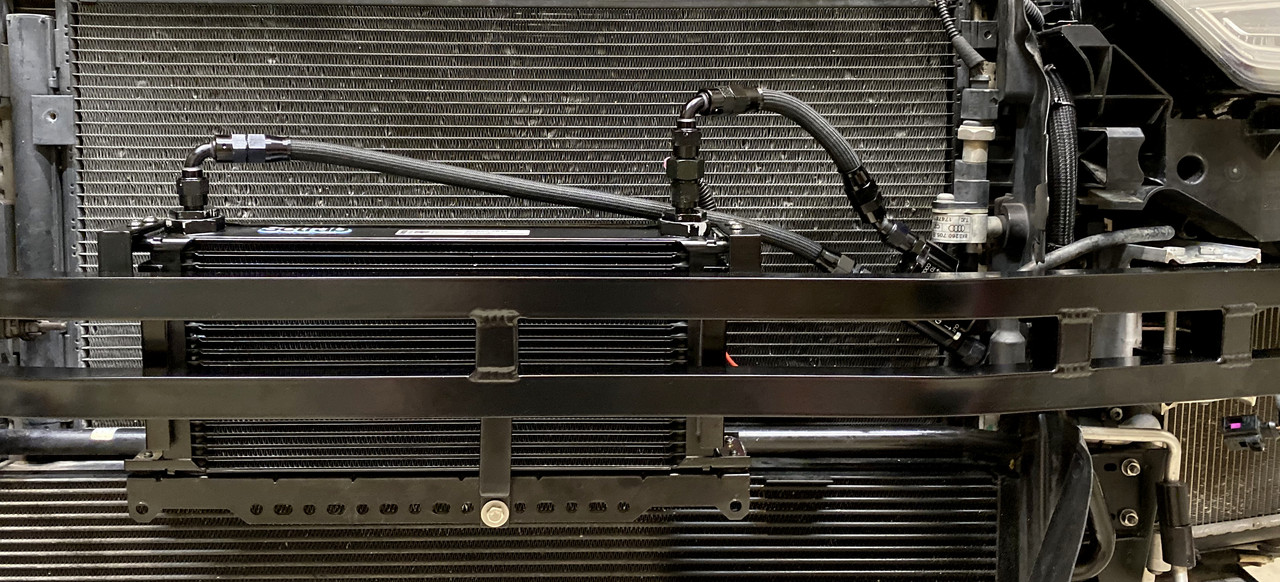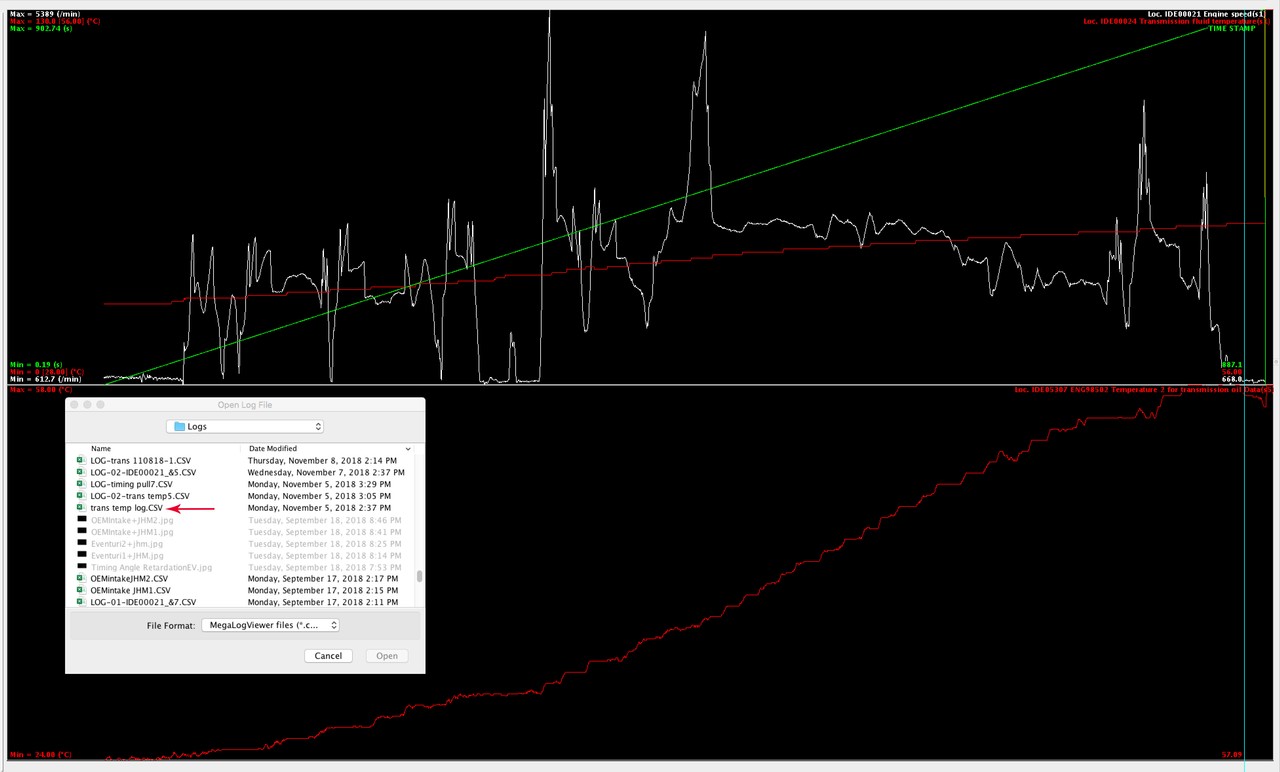Video gives most of the details but highly effective and no clue why this wasn’t done sooner. Systems being designed for the entire A4/A5 line (S/RS) and the S6 as well, pretty much anything running the Borg Warner DL-501 S-Tronic.
I’m now looking at the S5/S4 and should have something designed for those cars shortly. I also have one RS5 kit ready to go and four more slots available if anyone is interested.
Very impressive transmission cooler kit to say the least! There were no sacrifices made in the build quality and there’s nothing but positive results radiating from it. I’ll be installing my kit likely in Spring sometime. 
Agreed, It looks like a fantastic system, built to fix a really under talked about issue with the transmission temps.
The system looks very well made with parts that complement the RS5.
Great work.
I did a bunch of tests last weekend at the drag strip but unfortunately I forgot my PC’s power cord and I can’t get the files off of it until tonight. But the data is very promising and it performed very well. I was able to do back to back drag runs with no issues and it kept temp spikes in check. I also tested something new with the setup but can’t discuss it just yet 
Edit: Forgot to mention…will be headed back to the drag strip NEXT Sunday. Not this coming. Weather looks promising two Sundays out. Tomorrow it’ll be much like it was last week so not worth the time/effort to run the same times. But next week looks to be a 15 degree drop (peak) with cooler temps earlier and lower humidity. But it’s Texas so that’ll change six times between now and then.
So they may not be having test and tune at the drag strip tomorrow. The high is supposed to be 60F which is just about perfect between nice cool temps and the track getting too cold. Will be a shame, may need to head out to my secret test site and use the Dragy.
Anyway, I’ve had a few questions lately on the RMR kit and I thought I’d go back and look at some graphs with the OEM cooler.
The first thing which sort of stunned me was how long it took to heat up the ATF fluid. On a normal day, my coolant will reach operating temps well within two miles of city driving. My oil temps generally reach 140F within two miles and before I get on the highway. The ATF temps, however, after 15 minutes of highway driving, will not reach their stabilized plateau of about 90C. It’ll take an additional 15 minutes of driving. City driving with stop and go, car in gear at stoplights, will heat up the fluid quite quickly. The clutch, in particular, seems to generate most of the heat. While the clutch has it’s own “thermostat” in the form of a check valve, having a large pool of cool ATF fluid helps keep clutch temps in check too.
So here’s one of the FIRST logs I ever did of transmission temperatures. I knew how long it took the oil to come up to temperature but I was curious about the transmission. I did this way back in the fall of 2018. The high on that day was 79 degrees (thanks Google!).
I was pretty shocked at just how long the fluid needed to come up to temperature. I have a 15-20 minute drive to work, 30% city, 70% highway. In that time, 906 seconds to be exact, the fluid temps didn’t even reach 60C and came in far short of the 90-95C stabilization temp range. That’s normal driving. I’m estimating it’d take another 15 minutes of highway or 10 minutes of city driving to bring the temps up to the point where the hot coolant fluid would draw heat out of the ATF fluid. That’s a shockingly long time. This made me believe the OEM liquid to liquid heat exchanger was quite weak. Here’s that first log in graph form (I know you hate graphs Count!).
There are two graphs here, one above the other, same timeline.
Top Graph
Green=Time
White=RPM
Red=ATF fluid temps
Bottom Graph
Red=MTF fluid temperature
Edit: I also included the file name and date in the screen graph just for full transparency. See red arrow.
I’m going to go through various logs and find as many interesting “illustrations” as I can so everyone can plainly understand the shortcomings of the OEM system. I’ll be adding as many relevant graphs as I can find.
Also, I have the logs and I’d be happy to share them. I graph all of these using MegaLog Viewer HD which is far, far easier than doing everything in Excel. Just google it. It’s a cheap program too.
Here’s a “failure to launch” graph snippet. This is in March 26th, which had also had a high of 79 degrees. The red line is the ATF fluid temp, the green is rpm where I’m trying to initiate launch but it’s not having it. The fluid temp is 110C or 230F. That’s with the OEM cooler right after using LC once. So second time, mild temps, =failure. Now it gets well above 100F during the summer months so I think this is the point were I was taking a serious look at integrating a new cooler system into the car.
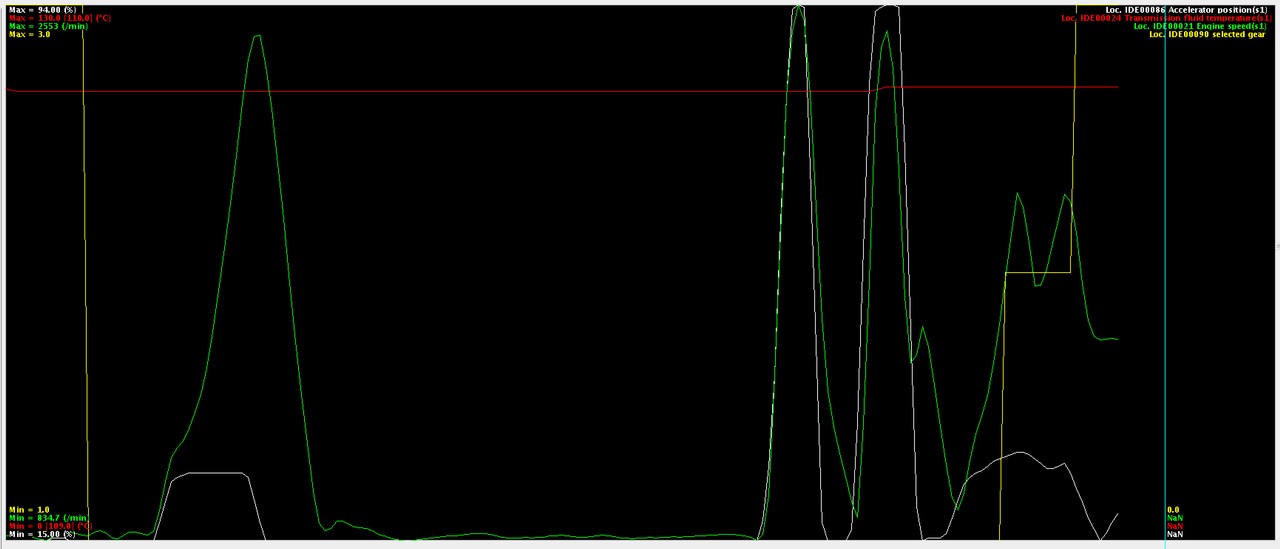
Here’s a look at the OEM cooler’s rate of heat dissipation. This graph represents a 12 minute snippet in time. Max rpm is approximately 2600rpm (white). This is most likely after a run through the hills, the fluid has already cooled a bit as I’d typically see well over 120C when hammering the back roads. The temps start at about 92C and heat up to 97 when I stop for a bit, car in gear. I then cruise at a normal pace and it takes a good chunk of time for the temps to come down to the high 80C range. This was taken on March 31, 2019 when the HIGH was only 58 degrees. Imagine on a mid 90 degree summer day.
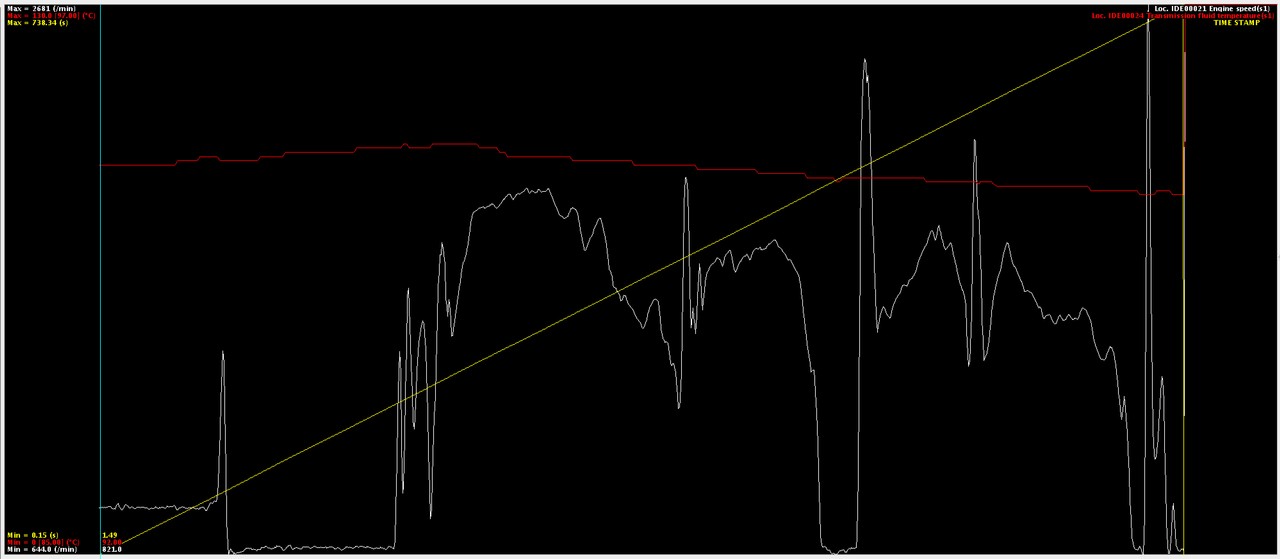
This next one is rather interesting. I was actually logging for other parameters as I was testing some software but I included trans fluid temps. What you’re seeing is a massive temp spike where the ATF fluid goes from 53C to 84C in seconds. I’ve shortened the amount of data and the fluid temp continues to rise to about 87C before I stop logging. This is with just a few bursts of throttle to redline in two gears. Like I said, I was actually logging for other data but just happened to catch this. Red is temp, white is rpm. Redline was 8400rpm+ Taken on April 8, 2019 with a high of 88F.
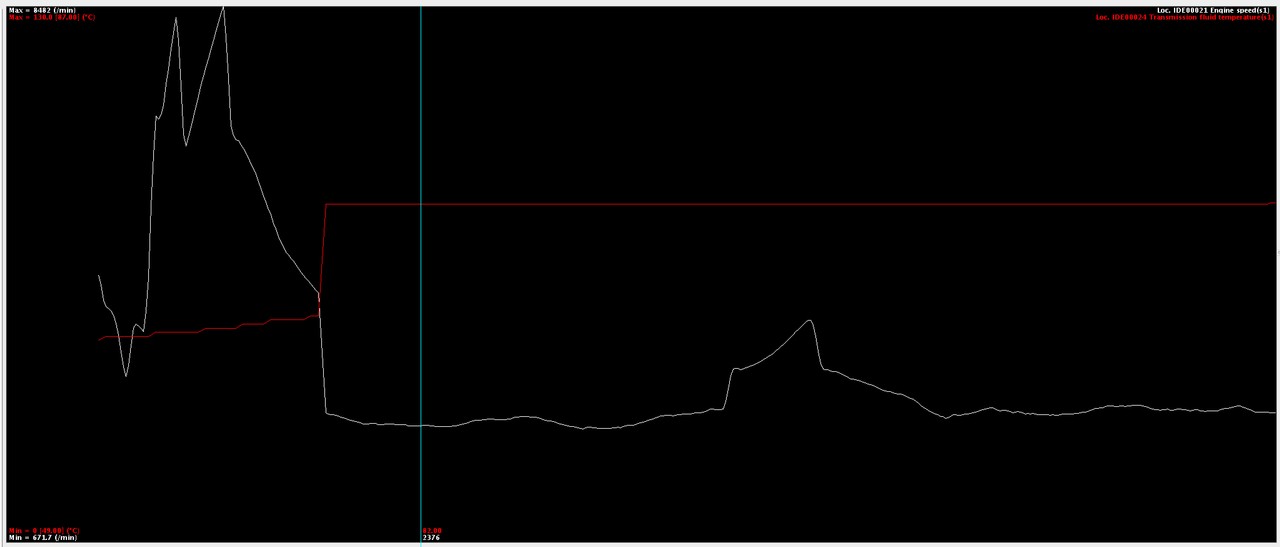
So…if I told you my nickname in high school was “geek”, would you believe me? I like to drive around with the VCDS logger up and running but not logging, just to periodically check on various parameters and see if there’s anything interesting that pops up. This is from an errand day, running around town in traffic, nothing too brutal, just general driving. The transmission temperatures here are between 100C and 102C. Again from April 8, 2019 with a high of 88 degrees, OEM cooler. Says it was from 6:14pm but that may have been the time I downloaded the original log. I remember taking that log in the middle of the day, round 2pm.
Red is ATF Temp
White is RPM. Max rpm is 2800.
The logging I did on that day is really what put everything in motion to develop this kit.
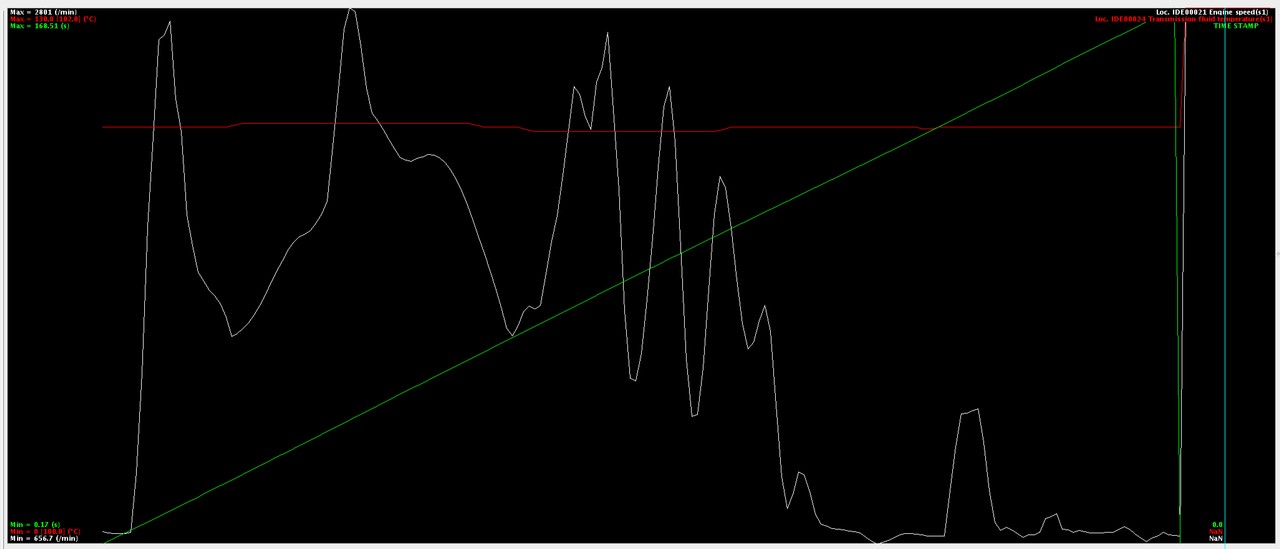
That’s some interesting data and very good to know. I know on my most recent launches, 2 back-to-back at night, that the temperature reached 230°F which at that point I knew to stop while I was ahead. Not too sure what the temperature was outside, but likely somewhere in the high 60s or low 70s (°F). I’m looking forward to seeing the difference with the kit.
I’ve also been thinking about how this kit will work in tandem with JHM’s supercharger. As you can imagine, still several questions about the SC and what all will be involved in it.
I’m currently working on an “evo” version of the kit specifically for the supercharger in tandem with a kit that’ll work with the S5 3.0T, specifically those individuals who’ve upgraded to a larger heat exchanger. There’s most likely, not enough room to run a fan pack on the S5 with an upgraded heat exchanger.
I’m making the assumption the RS5 supercharger kit will have a similar heat exchanger setup as the 3.0T with a main hx in the same spot, in front of the A/C condenser.
There will be no fan pack and as a result, will be less expensive. The only downside is it won’t perform as well, most likely, in stop and go traffic and moderate temps or at the drag strip. There is a slight improvement once moving, 2-3 degrees Centigrade.
It’ll perform just as well in hot temps. This may sound counter intuitive but I would assume anyone driving in hot temperatures will have their a/c on. With the a/c on and the main fans running at more than 10%, enough cool air is drawn through to keep the transmission temps low. Once moving it’s a non-issue.
And of course at the drag strip, the ability to have a fan pack is a bonus. No need to run the a/c and piss off the guy who has to prep the launch pad. If it’s a somewhat respectable track, I’ve seen people get kicked off the track for running a/c. Otherwise, run the a/c for a bit and shut it off a bit before you roll into the box and hope you’re not dripping water.
I’m currently testing the Evo version, no fans, day in and day out, in moderate temperatures. I’ve been fortunate in that we’ve gone from 40 to mid 80 degreee Fahrenheit temps here lately so lots of testing in different weather conditions and driving patterns.
The S5 version will be available soon. Working on brackets and hose routing and I’ll need a willing participant local to me to test out final installation. So if there are any S5 owners interested near San Antonio, TX, shoot me a message.
Will the RMR kit interfere with the JHM supercharger mounting hardware?
At this point I don’t have a solid answer for that as I’ve not seen any photos of the supercharger or how it’s mounted. I can say this…the S5, with its additional heat exchanger, still has the same “mounting” points surprisingly. Most of the hardware is actually mounted to the RMR cross bar so there’s no interference. The S5 has a few differences though in that the OEM heat exchanger is on the right (passenger’s side) of the radiator, like the A5.
You, being one of the first adopters, will be getting the Evo brackets and any hoses that need changing at no cost :). This’ll ensure you can run it with the supercharger. There are very few changes between the two kits but the evo version will move the transmission heat exchanger back towards the a/c condenser by about 2". The brackets are slotted so once you add the supercharger heat exchanger, you slide it forward a bit.
If they choose to mount the SC unit on the driver’s side, it’ll be easy to route the bottom hose elsewhere. So whatever they bring to market, I’ll make sure it’ll work with that kit.
With that said…the kit with the fan pack may actually fit and there’s still a gap in the front to slide the entire RMR trans cooler core forward another inch. I just won’t know until JHM releases the kit and we see how much room the supercharger heat exchanger takes up. Or if they even go that route. There are alternatives to a large, front mounted radiator-style heat exchanger.
That’s the long answer. The short answer is yes, there’s enough adjustment built in that it should work just fine.
Oh I love me some graphs.
This is absolutely such great work and such a needed product as well. Your posts help really tell the story. It’s hard to grab samples of odd situations and I don’t think most people understand how quickly the fluid temps can shoot up.
We need to see you get that 11 second pass now.
^^ Ditto!
Ok more fun with graphs. And yes, an 11 second pass would be nice! One thing I’ve noticed is a “soft” shift in comparison to others. I believe it’s the smaller clutch pack (2, 4, and 6) whereas the larger (1, 3, 5 and 7) is snappy in comparison. So possible clutch wear on my end or even a possibly weak main pressure solenoid for that gear set. It’s not super obvious but I did notice the other day. Ben’s car is far younger, LOL. I’d like to swap in a more aggressive clutch pack and apparently, you only need to run adaptation at a few select mileage points to adjust to the additional friction capability.
But back to graphs!
Going to post a few from my last visit to the drag strip. The main difference is I’m NOT using a fan pack. Cliff notes version, it was pretty stable. Ambient temps were as high as 78 and for the most part, the ATF fluid stayed in the 70’s with the clutch temps often reaching 20 degrees higher before cooling down at the end of the run. I made sure to do two things. First, I went to the furthest exit at the end of the run so the car had more airflow for a longer period of time. The second thing I did was run the a/c fans for a bit to help mediate temps. With the fan pack, they kick on at about 80C so you never have to think about it. Now if I just had a tuner that could maybe link trans temps to fan speed…hmm. When the ATF temps hit 80C, maybe turn the fans on, like 20%. Should do the trick without turning the a/c on.
Some graphs. These are large but I’ve included the graph color chart on the left. Again, this is the RMR trans cooler kit WITHOUT a fan pack.
This one was labeled drag run 2 (made nine passes that day).
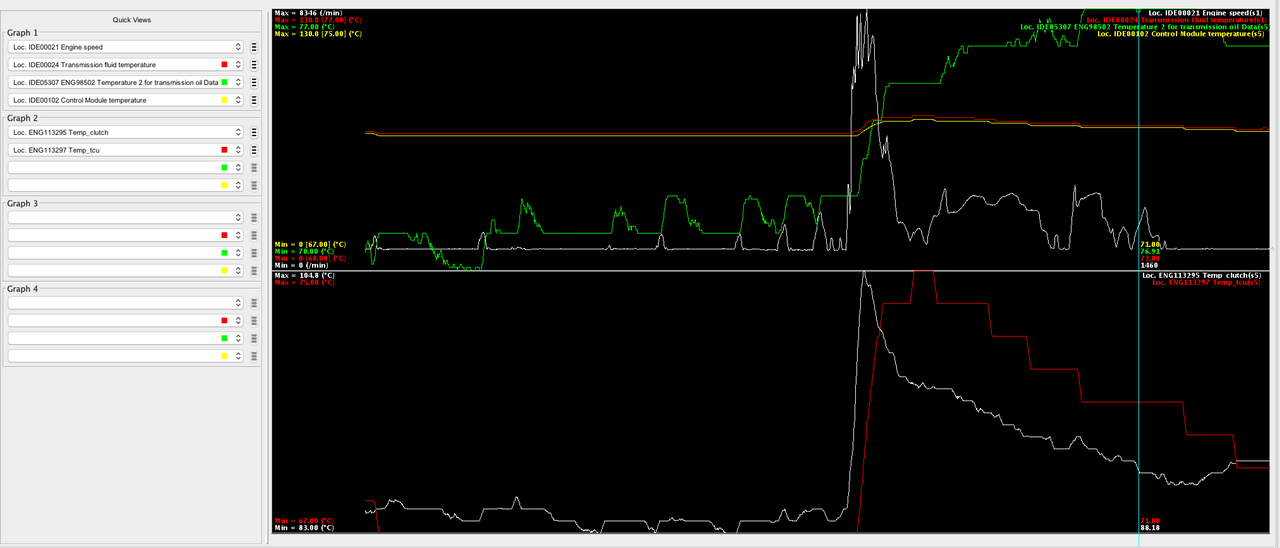
The thermostat generally stabilizes the temp at around 68-70C. I’ve started out at 71C (red/yellow line), sitting in the staging line. Max, at the end of the run is 77C and within seconds, it begins to cool down again. By the time I make it to the pits, it’s back down to 72 degrees. One note, not all the graphs are on the same axis. The green line is the manual transmission fluid on the gearbox side and it’s peak temp is also 77C but the way it’s graphed makes it look like it’s much hotter. It isn’t.
Here’s a closer view of the same drag run with more detail.

Now just imagine if you’re running the OEM cooler and it’s being “cooled” by 200 degree F (93C) coolant. The ATF fluid is already in the 90 degree range and the clutch would be 20 degrees hotter minimum. Not good!
Here’s drag run six of the night. Temps stay pretty stable. This was at 4 or 5pm in the afternoon when ambient air temps were at their peak.

I did not make all runs back to back to back. Just impossible. Once you circle back around, there’s a line which varies in length so sometimes you get to run within 10 minutes, sometimes it’s a half hour wait. You then spend time idling with five or six cars in front of you (at best!) as you slowly creep up to the start line waiting for your turn to run. Not ideal but it is what it is.
So how bout city driving? I did an experiment on Thursday. Ambient temperatures were 72 degrees which, for my tests, is idea as it’s unlikely the fans will come on unless you’re idling for an extended period of time. The VCDS does not allow you to log fan speed AND transmission temperatures. I need to see if I can request that. So it’s one or the other.
First graph is cold start and a drive downtown from my house. So same drive as the OEM cooler graph posted earlier. This time I threw in some city driving at the end though. The important part is after 900 seconds, the ATF temp with the RMR cooler is identical to the OEM cooler. So warmup time is exactly the same. And again, the gearbox temp graph is on another axis so it appears hotter but it’s peak temp is 65C.
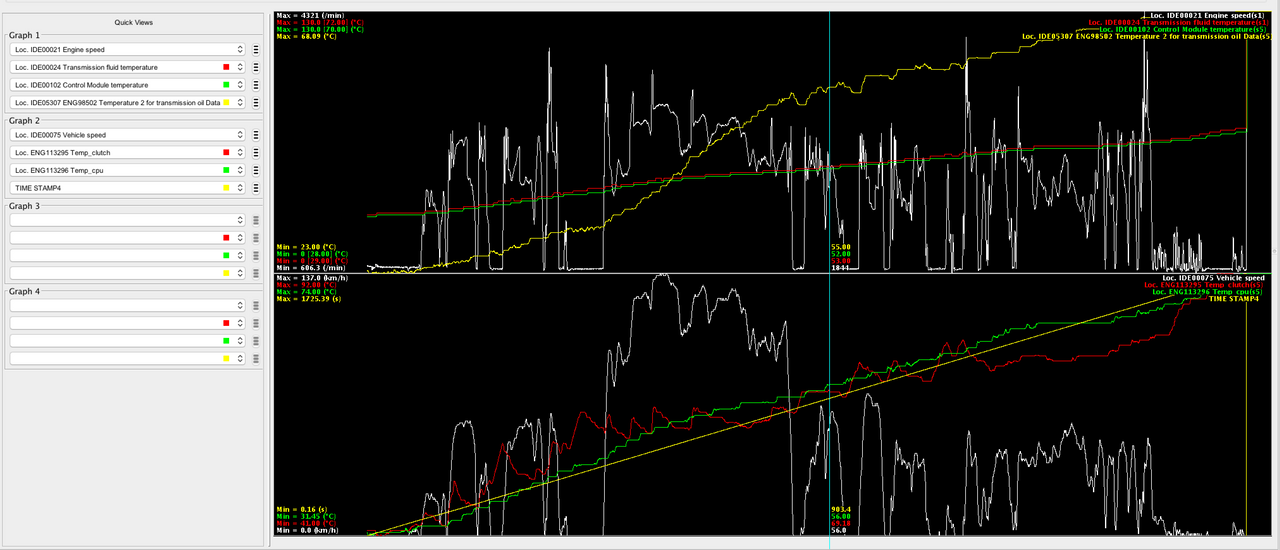
Torture test time…I logged from a hot start meaning I’d driven the car for a bit, it was warmed up, I began logging, then turned the car on. I drove around in the city, stoplight to stoplight with no issues. Temps stayed in the 70 degree range, no a/c fans on.
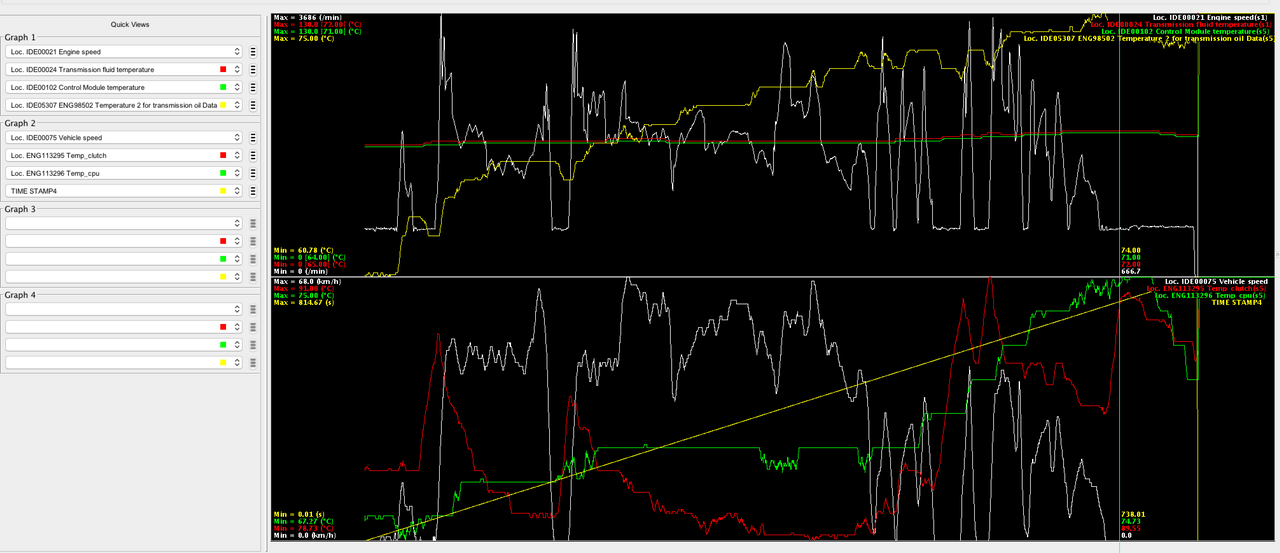
One really interesting aspect of the above graph is clutch temperature. The graph above is actually two graphs stacked on top of one and other. The bottom one, the red line is the clutch temp. See the spikes? Look at the white graph. That’s vehicle speed. Note the spikes come from when the car is stopped but in gear.
So far so good. I’ll continue testing but it looks like it’ll work as-is. I do believe, had I kept driving around, slowly, from stoplight to stoplight, the temps would have continued to rise into the 80C range but still damn safe and then some. Now if it’s moderately hot, you’ll probably turn the a/c on and the fans will kick in and the measured ATF temps will drop quickly.
Awesome!
The fan pack on the RMR cooler only turns on when you click on the AC?
Nada, with the fan pack it’s automatic. There’s a thermal switch which completes the circuit when temps hit 80c so it’s completely automatic.
It without the fan pack, in heavy traffic and mild temps, the atf temp has the potential to go higher than 80c unless the car’s fans are running. I position the cooler to be just in front of the a/c condenser so air is pulled through more efficiently than if I’d left it where it sits with the fan pack. If I left it in that position without the fan pack, air may go around the core instead of through it.
So with your climate, you’d benefit more having the fan pack. Me? During the summer the a/c is never turned off from May through October, lol.
So am i right in thinking that with the fan pack on when your stuck in traffic in gear we will not get the spikes of high temps unlike your getting with no fan packs ?
Does the default kit come with the fan pack? Sorry, I can’t recall!
These graphs are great! It would be helpful maybe if in your top post you listed the average trans temps of OEM vs RMR and the delta between the two for quick access of the following (graphs make it a bit hard to quickly decipher for users):
Race
Street (aggresive)
Daily (start/stop(
Yes we have the fan pack on our kit !
That is correct. The fan pack basically prevents the temps from getting much above 80 Celsius in slow traffic, mild temps. If it’s hot out, you’re most likely running the a/c. If it’s cold out, typical Brit winter weather, the fan pack will most likely never come on. It’s a very small range. If you’re moving at speed, the fan pack won’t come on and isn’t needed. It’s a precaution for low speed driving, like getting stuck on the motorway due to an accident or congestion where you’re creeping along for an hour.
I have yet to get the transmission fluid seriously hot without the fan pack. I’ve been running without the fans for almost two months now. Winters here vary wildly but generally I’m seeing daytime temps between 50F and 80F degrees. It was 79F today and 55F last Sunday. Not hot enough to run the a/c but I haven’t gotten stuck in serious traffic yet either. City driving, stoplight to stoplight, wasn’t an issue at all.
Yes, the standard “premium” kit has the fan pack, wiring harness, all the bells and whistles.
The “evo” kit won’t have the fan pack or the wiring harness but will have everything else the premium kit has.
I posted one graph, where I did the exact same drive, car already warmed up, and there was about a 20 degree difference between the two, normal driving. In the canyons, “hooning” it, it was even greater, about 40 degrees. I got up to 90C with the fan pack on a 95F degree day, I’d expect about 10 degrees lower without. This is on tight roads where you never hit redline in third gear. It’s all 1st and 2nd gear corners with some small straights where you get into third then hard on the brakes again.
On a road course, you’d get a ton of high speed airflow on every straight and I’d imagine it’d make a world of difference over the OEM cooler which would always be tied in to the coolant temps.

